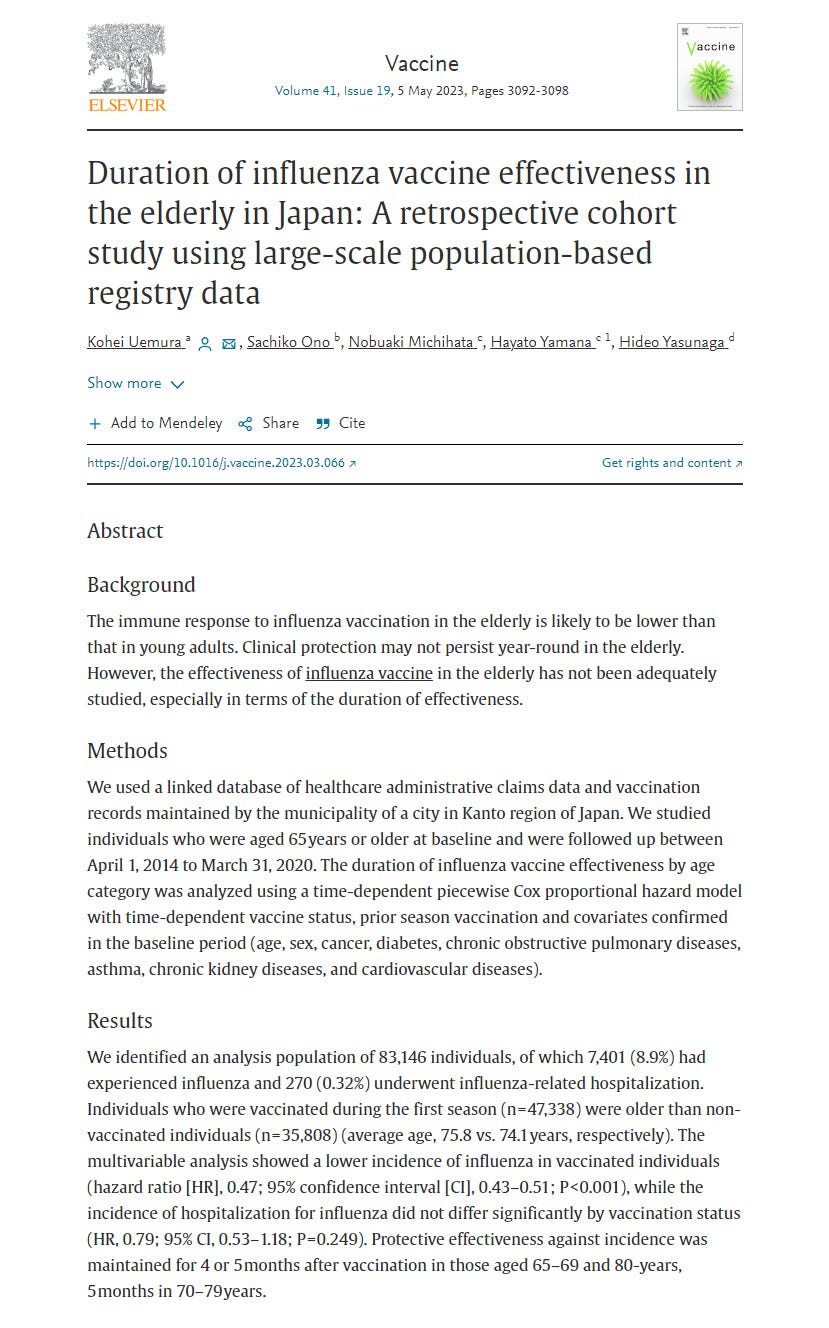Influenza Vaccine Fails to Stop Hospitalization and Death
Large Japanese Study Shows No Benefit on Hard Outcomes
By Peter A. McCullough, MD, MPH
Influenza vaccination has become a mainstay in American medicine largely as measure to protect the elderly. However in recently decades the FluShot has been pushed on healthcare workers, the general adult public, and starting in 2017 the CDC ACIP Panel stated: “Routine annual influenza vaccination is recommended for all persons age 6 months and older who do not have a contraindication.” I wondered if the FluShot even did was it was supposed to do originally in the elderly—protect against hospitalization and death. I was disappointed by real world data.
Uemura and coworkers from the Department of Biostatistics & Bioinformatics, Interfaculty Initiative in Information Studies, University of Tokyo, Japan reported on 83,146 individuals who were aged 65 years or older at baseline and were followed up between April 1, 2014 to March 31, 2020.

The multivariable analysis showed a lower incidence of influenza in vaccinated individuals (hazard ratio [HR], 0.47; 95% confidence interval [CI], 0.43-0.51; P < 0.001), however the incidence of hospitalization for influenza did not differ significantly by vaccination status (HR, 0.79; 95% CI, 0.53-1.18; P = 0.249). Protective effectiveness against incidence waned quickly after 4 or 5 months.
These data suggest the massive effort on vaccination in the general population is a waste of time and effort. If the frail and elderly get no overall direct reduction in hospitalization and death, influenza vaccination should be individualized based on pulmonary and systemic risks.
If you find “Courageous Discourse” enjoyable and useful to your endeavors, please subscribe as a paying or founder member to support our efforts in helping you engage in these discussions with family, friends, and your extended circles.





(Apologies if this appears more than once. The first two times I posted it, with a tick on the Notes option, and nothing happened.)
Research such as this is subject to a variety of confounders which can be hard to eliminate.
A more robust approach, at least for 65 year olds - who are widely regarded as more at risk of hospitalisation and death than younger people - is to survey hospitalisation and death by age, in years, and see how this varies with a strong rise in percentage of the population who take the flu vaccine each year.
Anderson et al. 2020, Annals of Internal Medicine https://sci-hub.se/10.7326/M19-3075 report that in England and Wales, over multiple flu seasons, there was no discernible change in the rate of hospitalisation and death, which rises with each year of age, around age 65 when the proportion of people who accept the flu vaccine rises from 27% to 57%. I discuss this and other research which backs this up in two articles, the first of which is https://nutritionmatters.substack.com/p/influenza-vaccines-do-not-reduce .
This is perfectly good research. The fact that the public - and surely most doctors - are not informed about this while at the same time are being cajoled and encouraged earnestly to accept this vaccine every year, shows that the multi-billion dollar flu vaccine is corrupt.
The flu vaccine is perhaps the least controversial of all vaccines. So why should we trust what the supposed experts tell us about any vaccine, without us first researching the matter assiduously to make sure all their statements accord with the best research?
Neither influenza nor COVID-19 would spread very much at any time of year if everyone had the 50 ng/mL 25-hydroxyvitamin D their immune system needs. Without proper vitamin D3 supplementation, most people have only 1/10 to 1/2 of this, so their innate and adaptive immune responses to cancer cells, bacteria, fungi and viruses is crippled. Please see all the research linked to and discussed at: https://vitamindstopscovid.info/00-evi/ .
This section: https://vitamindstopscovid.info/00-evi/#sjw-updated-ratios provides body-weight ratio amounts of vitamin D3 per day which will attain at least 50 ng/mL 125 nmol/L for people of all ages, bodyweights and degrees of obesity. This requires higher ratios for those suffering from obesity. These are from Prof. Sunil Wimalawansa's 2021 article in Nutrients:
"Rapidly Increasing Serum 25(OH)D Boosts the Immune System, against Infections - Sepsis and COVID-19": https://www.mdpi.com/2072-6643/14/14/2997 .
For 70 kg 154 lb body weight, without obesity, the amount to take, on average, per day is 0.125 milligrams. This is also known as "5000 IU". This is a gram every 22 years - and pharma grade vitamin D costs about USD$2.50 a gram ex-factory.
There is very little vitamin D3 in food, fortified or not. ~297 nanometre ultraviolet-B from sunlight or artificial sources can produce quite a lot of vitamin D3 in skin (white - not so much in brown or black skin), but this is not available to most people all year round, and always damages DNA, so raising the risk of skin cancer.
I never got a flu shot until I got a job at the Cleveland Clinic. My boss would yell from her office at those who balked. They had shot stations on carts setup throughout the campus. Once they tried putting holographic stickers on our badges to indicate compliance. It was, from my perspective, horrifying.
Many of my colleagues didn’t like being told they had to take these shots but in 13 years I only knew one person that successfully refused. Ironically enough I actually got the flu despite all the shots. Tested positive for influenza A. Couldn’t remember the time before when I caught the flu it was so long ago. Everyone at CCF just shrugged, it happens, you won’t get as sick, blah-blah-blah.
After I retired I said, thank God nobody can force me to take shots anymore. Little did I know the pandemic was just a few years away. I did not take the covid vaccine. But I did stock up on IVM. So when I finally caught Delta 1-1/2 years ago I survived. Haven’t had so much as a cold since.